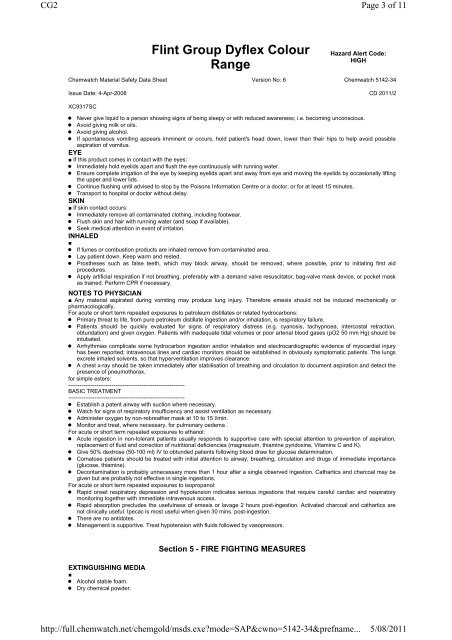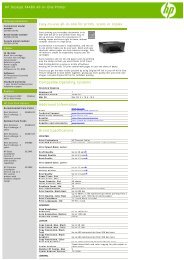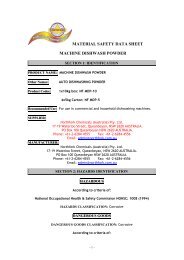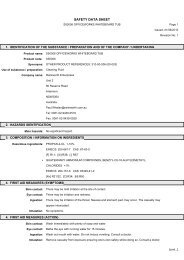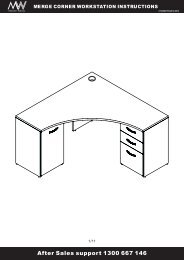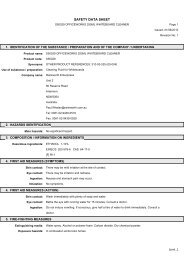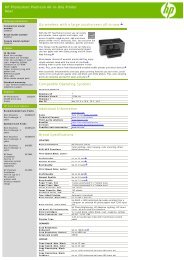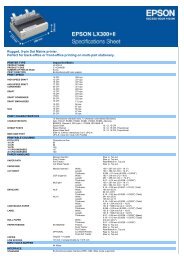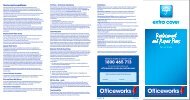Flint Group Dyflex Colour Range - Officeworks
Flint Group Dyflex Colour Range - Officeworks
Flint Group Dyflex Colour Range - Officeworks
You also want an ePaper? Increase the reach of your titles
YUMPU automatically turns print PDFs into web optimized ePapers that Google loves.
CG2Page 3 of 11<strong>Flint</strong> <strong>Group</strong> <strong>Dyflex</strong> <strong>Colour</strong><strong>Range</strong>Hazard Alert Code:HIGHChemwatch Material Safety Data Sheet Version No: 6 Chemwatch 5142-34Issue Date: 4-Apr-2008 CD 2011/2XC9317SC Never give liquid to a person showing signs of being sleepy or with reduced awareness; i.e. becoming unconscious. Avoid giving milk or oils. Avoid giving alcohol. If spontaneous vomiting appears imminent or occurs, hold patient's head down, lower than their hips to help avoid possibleaspiration of vomitus.EYE■ If this product comes in contact with the eyes: Immediately hold eyelids apart and flush the eye continuously with running water. Ensure complete irrigation of the eye by keeping eyelids apart and away from eye and moving the eyelids by occasionally liftingthe upper and lower lids. Continue flushing until advised to stop by the Poisons Information Centre or a doctor, or for at least 15 minutes. Transport to hospital or doctor without delay.SKIN■ If skin contact occurs: Immediately remove all contaminated clothing, including footwear. Flush skin and hair with running water (and soap if available). Seek medical attention in event of irritation.INHALED■ If fumes or combustion products are inhaled remove from contaminated area. Lay patient down. Keep warm and rested. Prostheses such as false teeth, which may block airway, should be removed, where possible, prior to initiating first aidprocedures. Apply artificial respiration if not breathing, preferably with a demand valve resuscitator, bag-valve mask device, or pocket maskas trained. Perform CPR if necessary.NOTES TO PHYSICIAN■ Any material aspirated during vomiting may produce lung injury. Therefore emesis should not be induced mechanically orpharmacologically.For acute or short term repeated exposures to petroleum distillates or related hydrocarbons: Primary threat to life, from pure petroleum distillate ingestion and/or inhalation, is respiratory failure. Patients should be quickly evaluated for signs of respiratory distress (e.g. cyanosis, tachypnoea, intercostal retraction,obtundation) and given oxygen. Patients with inadequate tidal volumes or poor arterial blood gases (pO2 50 mm Hg) should beintubated. Arrhythmias complicate some hydrocarbon ingestion and/or inhalation and electrocardiographic evidence of myocardial injuryhas been reported; intravenous lines and cardiac monitors should be established in obviously symptomatic patients. The lungsexcrete inhaled solvents, so that hyperventilation improves clearance. A chest x-ray should be taken immediately after stabilisation of breathing and circulation to document aspiration and detect thepresence of pneumothorax.for simple esters:--------------------------------------------------------------BASIC TREATMENT-------------------------------------------------------------- Establish a patent airway with suction where necessary. Watch for signs of respiratory insufficiency and assist ventilation as necessary. Administer oxygen by non-rebreather mask at 10 to 15 l/min. Monitor and treat, where necessary, for pulmonary oedema .For acute or short term repeated exposures to ethanol: Acute ingestion in non-tolerant patients usually responds to supportive care with special attention to prevention of aspiration,replacement of fluid and correction of nutritional deficiencies (magnesium, thiamine pyridoxine, Vitamins C and K). Give 50% dextrose (50-100 ml) IV to obtunded patients following blood draw for glucose determination. Comatose patients should be treated with initial attention to airway, breathing, circulation and drugs of immediate importance(glucose, thiamine). Decontamination is probably unnecessary more than 1 hour after a single observed ingestion. Cathartics and charcoal may begiven but are probably not effective in single ingestions.For acute or short term repeated exposures to isopropanol: Rapid onset respiratory depression and hypotension indicates serious ingestions that require careful cardiac and respiratorymonitoring together with immediate intravenous access. Rapid absorption precludes the usefulness of emesis or lavage 2 hours post-ingestion. Activated charcoal and cathartics arenot clinically useful. Ipecac is most useful when given 30 mins. post-ingestion. There are no antidotes. Management is supportive. Treat hypotension with fluids followed by vasopressors.Section 5 - FIRE FIGHTING MEASURESEXTINGUISHING MEDIA■ Alcohol stable foam. Dry chemical powder.http://full.chemwatch.net/chemgold/msds.exe?mode=SAP&cwno=5142-34&prefname...5/08/2011


